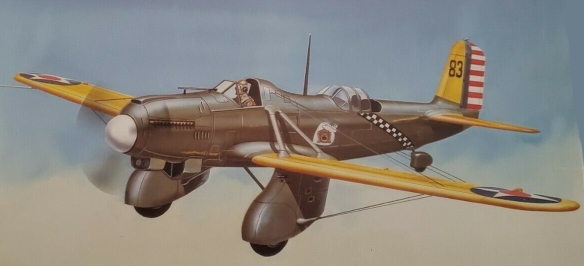
A Curtiss A-8 Shrike of the 13th Attack Squadron during evaluation by the USAAC which resulted in a 46-strong order for the A-12.
One of 20 `export’ A-12s that were delivered to the Chinese Nationalist Air Force in 1936, all of which saw subsequent action against the Japanese the following year.
The sole YA-10 (Model 59B) was the first YA-8 (32-344) to be converted with a 625hp Pratt & Whitney Hornet air-cooled radial engine.
The US Army attack bomber requirement, issued in 1929, saw designs offered by Atlantic-Fokker in the shape of the XA-7 and Curtiss with its XA-8. It was the latter that was selected, an aircraft that would go on to become the USAAC’s main attack aircraft for the majority of the 1930s.
Designed by Don Berlin, the A-8 `Shrike’ was an impressive aircraft which featured a large number of advances and firsts for Curtiss in one respect but, in another, ideas that dated back to the First World War. The aircraft was the first all-metal low-wing monoplane to be built by Curtiss. It was fitted with advancements such as leading-edge slots and trailing edge flaps but was also installed with strut and wire-braced wings, which, with the exception of the Douglas O-31 and Boeing P-36, had not been seen since the First World War.
The pilot and an observer/gunner were positioned in widely spaced cockpits, the former under a fully enclosed canopy (only for the XA-8, all other variants were open) and the latter only protected by an extended windscreen. Power for the XA-8 and the production YA-8 (Model 59A) and Y1A-8 was 600hp Curtiss V-1570C inline engine with a radiator below the nose but the experimental YA-10 (Model 49B) was powered by a Pratt & Whitney R-1690-9 Hornet radial. The radial engine was the preference of the US Navy, especially for carrier borne operations, and the resulting production order was for the A-12 (Model 60). Still fitted with open cockpits, the A-12 had the rear cockpit moved much closer to the pilots in order to improve communications.
The XA-8 prototype was first flown in June 1931 and was followed by the first of eight service test aircraft which joined the USAAC from April 1932. Serving with the 13th Attack Squadron, 3rd Attack Group at Fort Crockett, Texas, the A-8 took the USAAC by storm, the service up until then having only operated biplanes. The main production variant, the A-12, entered service from 1934 with the 8th and 18th Attack Squadron, 3rd Attack Group. At least nine A-12s were operational at Hickam Field during the attack on Pearl Harbor and the type remained in service until 1942.
20 A-12s joined the Chinese Nationalist Force in May 1936, serving with the 27th and 28th Squadrons, 9th Group, but after some initial success, very few survived the Japanese onslaught in the summer of 1937.
Some 13 D1A1s stumbled on the Chinese secondary airfield at Chao-Er, where 12 Curtiss Shrike attack aeroplanes of the Chinese 26th and 27th Squadrons of the 9th Attack Group were preparing for a strike on Shanghai. A dogfight duly ensued between two unlikely opponents, namely carrier dive-bombers and ground-strafing attack aeroplanes. Two D1A1s were shot down and a third machine was seriously damaged, returning to Kaga with a fatally wounded crewman onboard. The Chinese in return lost five Shrikes, two in takeoff accidents.
One XA-8 prototype (30-387) was built, followed by five YA-8 (32-344 to 32-348) and eight Y1A-8 (32-349 to 32-356) service test aircraft; twelve of the service test machines were re-designated A-8. The first YA-8 was converted to the YA-10 and one XS2C-1 Shrike (Model 69) which became the first two-seat combat monoplane to be evaluated by the US Navy since the early 1920s. The main production variant was the A-12, of which 46 were built (33-212 to 33-257), at a cost of $19,483 each, minus GFE. 20 A-12s (c/n 12155-12174) were sold to China and deliveries commenced from May 1936 at a cost of $24,328.45.
JUN 1931 Maiden flight of XA-8, 30-387
APR 1932 A-8 joins 3rd Attack Group
DEC 1932 Development of YA-10, the XS2C-1, delivered to USN
1934 A-12 entered service
AUG 15, 1937 Four Japanese D1A1s shot down by Chinese A-12s
1942 Trainers retired by USAAF. As they were replaced by newer aircraft, 15 A-12s were assigned to Kelly Field, Texas as trainers and 20 went to the 26th Attack Squadron in Hawaii, where they served until 1941.
Specifications (A-12 Shrike)
General characteristics
Crew: 2
Length: 32 ft 3 in (9.83 m)
Wingspan: 44 ft 0 in (13.41 m)
Height: 9 ft 0 in (2.74 m)
Wing area: 284 sq ft (26.4 m2)
Empty weight: 3,898 lb (1,768 kg)
Gross weight: 5,756 lb (2,611 kg)
Powerplant: × Wright R-1820-21 Cyclone 9-cylinder air-cooled radial piston engine, 690 hp (510 kW)
Propellers: 3-bladed fixed-pitch propeller
Performance
Maximum speed: 176.7 mph (284.4 km/h, 153.5 kn)
Cruise speed: 151 mph (243 km/h, 131 kn)
Range: 521 mi (838 km, 453 nmi)
Service ceiling: 15,150 ft (4,620 m)
Rate of climb: 1,170 ft/min (5.9 m/s)
Armament
Guns:
4 × forward-firing 0.300 in (7.6 mm) M1919 Browning machine guns mounted in the wheel fairings
1 × 0.300 in (7.6 mm) machine gun mounted in the observer’s cockpit for rear defense
Bombs: Up to 4 × 122 lb (55 kg) bombs carried under the wings or up to 10 × 30 lb (14 kg) fragmentation bombs in fuselage chutes either side of the main fuel tank